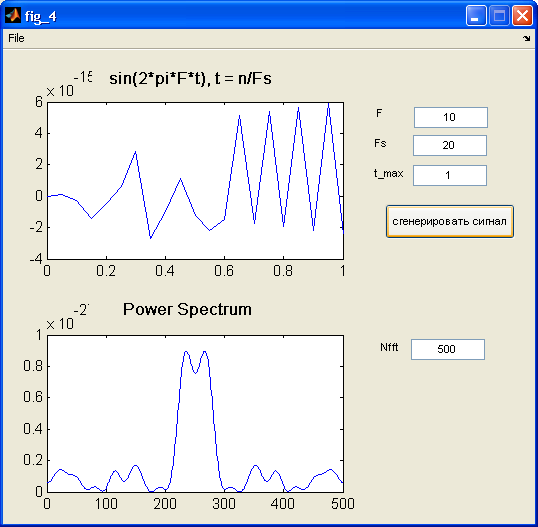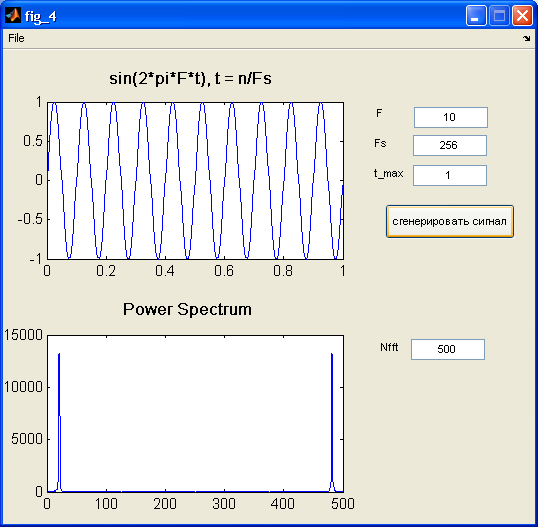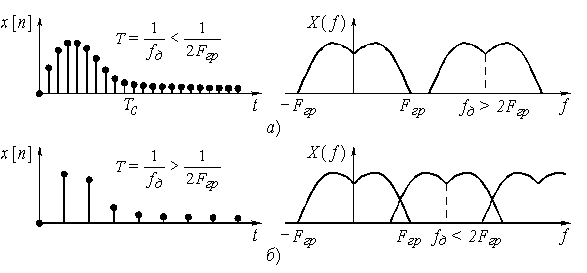
- •1. Цель выполнения задания
- •2. Теоретическое введение
- •Спектр сигнала, ограниченного во времени
- •Использование командного режима
- •3.Порядок выполнения работы
- •4. Реализация
- •4.1 Исследование периодических сигналов
- •4.2. Исследование окон
- •4.3. Исследование спектра сигналов, ограниченных во времени
- •4.4. Исследование растекания спектра
- •4.5. Исследование эффекта подмены частот
- •5. Вывод
- •Контрольные вопросы
4.5. Исследование эффекта подмены частот
4.5.1 Примеры введения различных частот дискретизации:

В данном случае нарушаются условия теоремы Котельникова. Слишком мала частота дискретизации.

В данном случае выполняются условия теоремы Котельникова.
4.5.2. Текст программы:
function varargout = fig_4(varargin)
% FIG_4 M-file for fig_4.fig
% FIG_4, by itself, creates a new FIG_4 or raises the existing
% singleton*.
%
% H = FIG_4 returns the handle to a new FIG_4 or the handle to
% the existing singleton*.
%
% FIG_4('CALLBACK',hObject,eventData,handles,...) calls the local
% function named CALLBACK in FIG_4.M with the given input arguments.
%
% FIG_4('Property','Value',...) creates a new FIG_4 or raises the
% existing singleton*. Starting from the left, property value pairs are
% applied to the GUI before fig_4_OpeningFunction gets called. An
% unrecognized property name or invalid value makes property application
% stop. All inputs are passed to fig_4_OpeningFcn via varargin.
%
% *See GUI Options on GUIDE's Tools menu. Choose "GUI allows only one
% instance to run (singleton)".
%
% See also: GUIDE, GUIDATA, GUIHANDLES
% Copyright 2002-2003 The MathWorks, Inc.
% Edit the above text to modify the response to help fig_4
% Last Modified by GUIDE v2.5 24-Apr-2006 14:19:31
% Begin initialization code - DO NOT EDIT
gui_Singleton = 1;
gui_State = struct('gui_Name', mfilename, ...
'gui_Singleton', gui_Singleton, ...
'gui_OpeningFcn', @fig_4_OpeningFcn, ...
'gui_OutputFcn', @fig_4_OutputFcn, ...
'gui_LayoutFcn', [] , ...
'gui_Callback', []);
if nargin && ischar(varargin{1})
gui_State.gui_Callback = str2func(varargin{1});
end
if nargout
[varargout{1:nargout}] = gui_mainfcn(gui_State, varargin{:});
else
gui_mainfcn(gui_State, varargin{:});
end
% End initialization code - DO NOT EDIT
% --- Executes just before fig_4 is made visible.
function fig_4_OpeningFcn(hObject, eventdata, handles, varargin)
% This function has no output args, see OutputFcn.
% hObject handle to figure
% eventdata reserved - to be defined in a future version of MATLAB
% handles structure with handles and user data (see GUIDATA)
% varargin command line arguments to fig_4 (see VARARGIN)
% Choose default command line output for fig_4
handles.output = hObject;
% Update handles structure
guidata(hObject, handles);
% This sets up the initial plot - only do when we are invisible
% so window can get raised using fig_4.
if strcmp(get(hObject,'Visible'),'off')
genSIN_1(handles);
end
% UIWAIT makes fig_4 wait for user response (see UIRESUME)
% uiwait(handles.figure1);
% --- Outputs from this function are returned to the command line.
function varargout = fig_4_OutputFcn(hObject, eventdata, handles)
% varargout cell array for returning output args (see VARARGOUT);
% hObject handle to figure
% eventdata reserved - to be defined in a future version of MATLAB
% handles structure with handles and user data (see GUIDATA)
% Get default command line output from handles structure
varargout{1} = handles.output;
% --- Executes on button press in pushbutton1.
function pushbutton1_Callback(hObject, eventdata, handles)
% hObject handle to pushbutton1 (see GCBO)
% eventdata reserved - to be defined in a future version of MATLAB
% handles structure with handles and user data (see GUIDATA)
genSIN_1(handles);
%popup_sel_index = 1;%get(handles.popupmenu1, 'Value');
%switch popup_sel_index
% case 1
% plot(rand(5));
% case 2
% plot(sin(1:0.01:25.99));
% case 3
% bar(1:.5:10);
% case 4
% plot(membrane);
% case 5
% surf(peaks);
%end
% --------------------------------------------------------------------
function FileMenu_Callback(hObject, eventdata, handles)
% hObject handle to FileMenu (see GCBO)
% eventdata reserved - to be defined in a future version of MATLAB
% handles structure with handles and user data (see GUIDATA)
% --------------------------------------------------------------------
function OpenMenuItem_Callback(hObject, eventdata, handles)
% hObject handle to OpenMenuItem (see GCBO)
% eventdata reserved - to be defined in a future version of MATLAB
% handles structure with handles and user data (see GUIDATA)
file = uigetfile('*.fig');
if ~isequal(file, 0)
open(file);
end
% --------------------------------------------------------------------
function PrintMenuItem_Callback(hObject, eventdata, handles)
% hObject handle to PrintMenuItem (see GCBO)
% eventdata reserved - to be defined in a future version of MATLAB
% handles structure with handles and user data (see GUIDATA)
printdlg(handles.figure1)
% --------------------------------------------------------------------
function CloseMenuItem_Callback(hObject, eventdata, handles)
% hObject handle to CloseMenuItem (see GCBO)
% eventdata reserved - to be defined in a future version of MATLAB
% handles structure with handles and user data (see GUIDATA)
selection = questdlg(['Close ' get(handles.figure1,'Name') '?'],...
['Close ' get(handles.figure1,'Name') '...'],...
'Yes','No','Yes');
if strcmp(selection,'No')
return;
end
delete(handles.figure1)
% --- Executes on selection change in popupmenu1.
function popupmenu1_Callback(hObject, eventdata, handles)
% hObject handle to popupmenu1 (see GCBO)
% eventdata reserved - to be defined in a future version of MATLAB
% handles structure with handles and user data (see GUIDATA)
% Hints: contents = get(hObject,'String') returns popupmenu1 contents as cell array
% contents{get(hObject,'Value')} returns selected item from popupmenu1
% --- Executes during object creation, after setting all properties.
function popupmenu1_CreateFcn(hObject, eventdata, handles)
% hObject handle to popupmenu1 (see GCBO)
% eventdata reserved - to be defined in a future version of MATLAB
% handles empty - handles not created until after all CreateFcns called
% Hint: popupmenu controls usually have a white background on Windows.
% See ISPC and COMPUTER.
if ispc
set(hObject,'BackgroundColor','white');
else
set(hObject,'BackgroundColor',get(0,'defaultUicontrolBackgroundColor'));
end
%set(hObject, 'String', {'plot(rand(5))', 'plot(sin(1:0.01:25))', 'bar(1:.5:10)', 'plot(membrane)', 'surf(peaks)'});
function edit2_Callback(hObject, eventdata, handles)
% hObject handle to edit2 (see GCBO)
% eventdata reserved - to be defined in a future version of MATLAB
% handles structure with handles and user data (see GUIDATA)
% Hints: get(hObject,'String') returns contents of edit2 as text
% str2double(get(hObject,'String')) returns contents of edit2 as a double
% --- Executes during object creation, after setting all properties.
function edit2_CreateFcn(hObject, eventdata, handles)
% hObject handle to edit2 (see GCBO)
% eventdata reserved - to be defined in a future version of MATLAB
% handles empty - handles not created until after all CreateFcns called
% Hint: edit controls usually have a white background on Windows.
% See ISPC and COMPUTER.
if ispc && isequal(get(hObject,'BackgroundColor'), get(0,'defaultUicontrolBackgroundColor'))
set(hObject,'BackgroundColor','white');
end
% --- Executes on button press in pushbutton4.
function pushbutton4_Callback(hObject, eventdata, handles)
% hObject handle to pushbutton4 (see GCBO)
% eventdata reserved - to be defined in a future version of MATLAB
% handles structure with handles and user data (see GUIDATA)
function edit3_Callback(hObject, eventdata, handles)
% hObject handle to edit3 (see GCBO)
% eventdata reserved - to be defined in a future version of MATLAB
% handles structure with handles and user data (see GUIDATA)
% Hints: get(hObject,'String') returns contents of edit3 as text
% str2double(get(hObject,'String')) returns contents of edit3 as a double
% --- Executes during object creation, after setting all properties.
function edit3_CreateFcn(hObject, eventdata, handles)
% hObject handle to edit3 (see GCBO)
% eventdata reserved - to be defined in a future version of MATLAB
% handles empty - handles not created until after all CreateFcns called
% Hint: edit controls usually have a white background on Windows.
% See ISPC and COMPUTER.
if ispc && isequal(get(hObject,'BackgroundColor'), get(0,'defaultUicontrolBackgroundColor'))
set(hObject,'BackgroundColor','white');
end
function edit4_Callback(hObject, eventdata, handles)
% hObject handle to edit4 (see GCBO)
% eventdata reserved - to be defined in a future version of MATLAB
% handles structure with handles and user data (see GUIDATA)
% Hints: get(hObject,'String') returns contents of edit4 as text
% str2double(get(hObject,'String')) returns contents of edit4 as a double
% --- Executes during object creation, after setting all properties.
function edit4_CreateFcn(hObject, eventdata, handles)
% hObject handle to edit4 (see GCBO)
% eventdata reserved - to be defined in a future version of MATLAB
% handles empty - handles not created until after all CreateFcns called
% Hint: edit controls usually have a white background on Windows.
% See ISPC and COMPUTER.
if ispc && isequal(get(hObject,'BackgroundColor'), get(0,'defaultUicontrolBackgroundColor'))
set(hObject,'BackgroundColor','white');
end
% unsere
function genSIN_1(handles)
FREQstr = get(handles.edit2, 'String');
FREQnum = str2num(FREQstr);
FREQSstr = get(handles.edit3, 'String');
FREQSnum = str2num(FREQSstr);
TMAXstr = get(handles.edit4, 'String');
TMAXnum = str2num(TMAXstr);
STEP = TMAXnum/FREQSnum;
T = 0:STEP:TMAXnum;
SIGSIN = sin(2*pi*FREQnum*T);
axes(handles.axes1);
cla;
plot(T, SIGSIN);
NFFTstr = get(handles.edit5, 'String');
NFFTnum = str2num(NFFTstr);
POWERS = fft(SIGSIN, NFFTnum);
POWERSPECTR = POWERS.*conj(POWERS);
axes(handles.axes3);
cla;
%plot((1:20), POWERSPECTR(1:20));
plot(POWERSPECTR);
function edit5_Callback(hObject, eventdata, handles)
% hObject handle to edit5 (see GCBO)
% eventdata reserved - to be defined in a future version of MATLAB
% handles structure with handles and user data (see GUIDATA)
% Hints: get(hObject,'String') returns contents of edit5 as text
% str2double(get(hObject,'String')) returns contents of edit5 as a double
% --- Executes during object creation, after setting all properties.
function edit5_CreateFcn(hObject, eventdata, handles)
% hObject handle to edit5 (see GCBO)
% eventdata reserved - to be defined in a future version of MATLAB
% handles empty - handles not created until after all CreateFcns called
% Hint: edit controls usually have a white background on Windows.
% See ISPC and COMPUTER.
if ispc && isequal(get(hObject,'BackgroundColor'), get(0,'defaultUicontrolBackgroundColor'))
set(hObject,'BackgroundColor','white');
end
4.5.3. Файлы, относящиеся к програме:
- fig_4.fig– файл графического интерфейса
- fig_4.m– файл с функциями, обрабатывающими графическую форму
4.5.4. Запуск программы:
>> fig_4
4.5.5. Вывод:
Эффект подмены частот проявляется при выборе слишком низкой частоты дискретизации сигнала, т. е. ниже удвоенной максимальной частоты фурье-спектра сигнала.
В этом случае нарушаются условия теоремы Котельникова и высокочастотные гармоники сигнала или гармоники, частота которых выше половины выбранной частоты дискретизации, воспринимаются в полученной выборке как низкочастотные гармоники, т. е. гармоники, частота которых ниже половины частоты дискретизации.
Теорема Котельникова:Если сигналx(t) имеет
преобразование ФурьеX(jw)
такое, чтоX(jw)
= 0 приw>= 2πFN(FN–
частота Найкриста), тоx(t)
может быть восстановлен единственным
образом по последовательности
равноотстоящих отсчетовx(nT),
гдеn= -![]() ..
..![]() .
(то есть должно быть так:FД
.
(то есть должно быть так:FД![]() 2FN).
2FN).
Частота дискретизации непрерывного
сигнала не должна быть меньше удвоенной
ширины спектра:
![]() иначе
произойдет наложение спектров (рис. б)
и будет невозможно с помощью фильтра
нижних частот выделить спектр исходного
непрерывного сигнала.
иначе
произойдет наложение спектров (рис. б)
и будет невозможно с помощью фильтра
нижних частот выделить спектр исходного
непрерывного сигнала.

